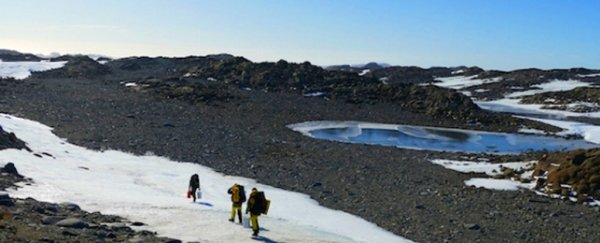While bacteria are often associated with icky germs, they really are so much more than that. They help us digest things, feed trees nitrogen, play a huge role in cycling Earth's nutrients, and survive staggering extremes. Recently, we discovered some of these incredibly tough and tiny packages of life can even live off air alone.
A few years back, scientists discovered bacteria in Antarctic soils that not only breathe air, but eat it too. Now, a new study shows these microbes could be present elsewhere, detected via genetic analysis of soils from the three most icy regions of our planet - the Arctic, Antarctic, and the Tibetan Plateau.
As these bacteria have so far been detected in very low nutrient environments, they likely play a key role in fuelling the (admittedly sparse) life around them.
"There are whole ecosystems probably relying on this novel microbial carbon fixation process where microbes use the energy obtained from breathing in atmospheric hydrogen gas to turn carbon dioxide from the atmosphere into carbon – in order to grow," explained microbiologist Belinda Ferrari from the University of New South Wales (UNSW) in Australia.
The process - called atmospheric chemosynthesis - joins photosynthesis and geothermal chemotrophy as yet another way primary producers can make their own organic building blocks for growth and energy storage, using reactions based on inorganic materials.
These particular bacteria oxidise hydrogen from the air to drive a series of reactions that convert atmospheric carbon into living tissues, which other lifeforms can then also make use of - by consuming.
"We think this process occurs simultaneously alongside photosynthesis when conditions change, such as during the polar winter when there is no light," said Ferrari.
"So, while more work is needed to confirm this activity occurs globally, the fact that we detected the target genes in the soils of the three poles means this novel process likely occurs in cold deserts around the world, but has simply been overlooked until now."
Their eating habits, which directly remove carbon from the atmosphere, and the fact that they may be more widespread than we realised, reveal another potential carbon sink.
"Our finding probably indicates atmospheric chemosynthesis is contributing to the global carbon budget," said Ferrari.
Microbial ecologist Angelique Ray, Ferrari, and their colleagues searched 122 soil samples from 14 ice-free, cold desert sites for genes uniquely linked to atmospheric chemosynthesis. These sites are exposed to regular freeze-thaw cycles, scorching UV radiation, and extremely low levels of moisture, carbon, and nitrogen.
Here, even photosynthesising microbes are rare. Nevertheless, the researchers found these genes in different abundances at every single site.
The team suspects microbes making use of this low-resource carbon fixation strategy may be widespread through nutrient-starved desert regions, which are set to increase due to global warming.
These largely barren areas currently span 35 percent of Earth's surface, but by the end of the century are expected to cover up to 56 percent.
The researchers now hope to isolate air-munching bacteria to learn more about them, and search for signs of their presence in other ecosystems.
With some luck (and lots of hard work) these communities of cells could increase our understanding of our planet's life-essential carbon fixation systems and provide insights into the possibility of similar lifeforms existing elsewhere in our Universe.
If bacteria can survive by just devouring Earth's atmosphere, they could well be doing a similar thing elsewhere in the Solar System and beyond.
This study was published in Frontiers in Microbiology.
